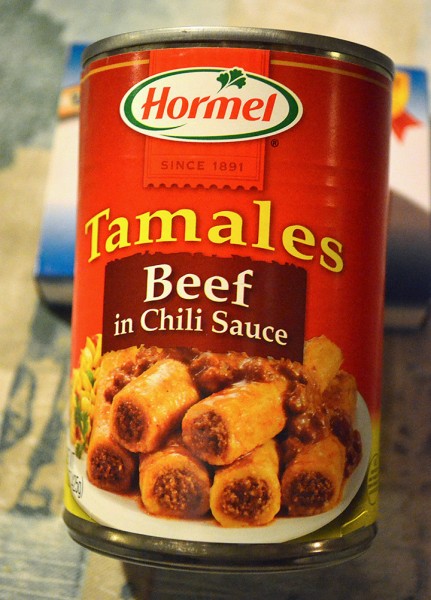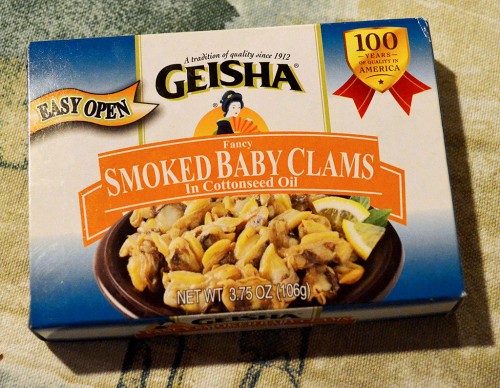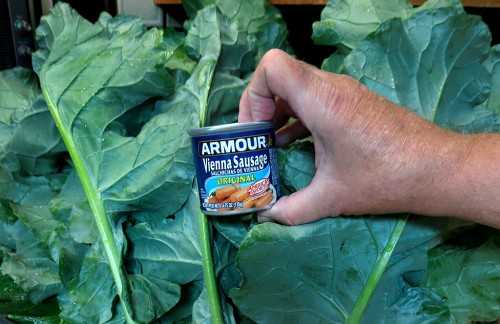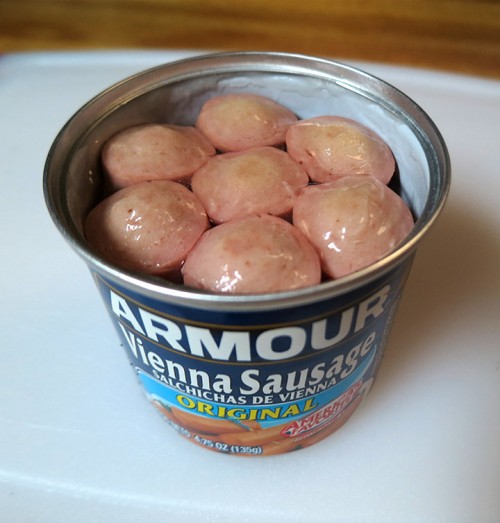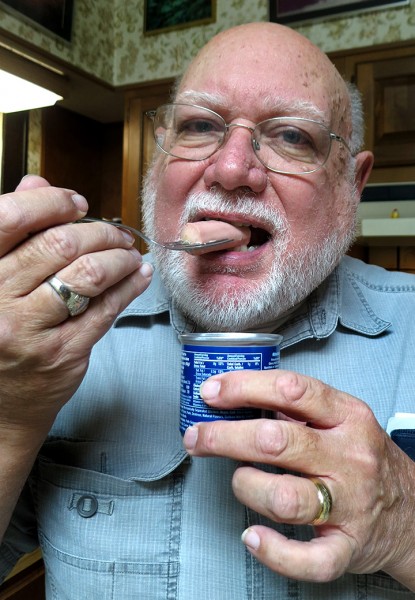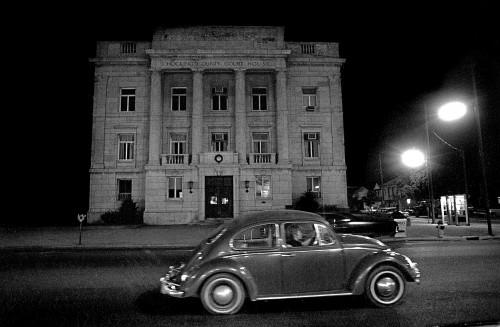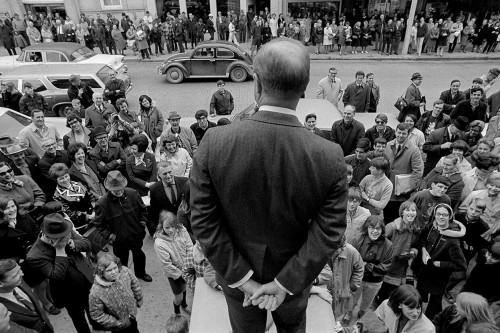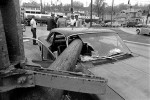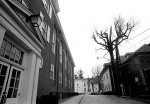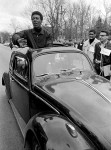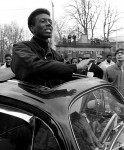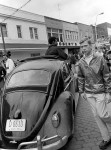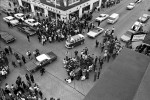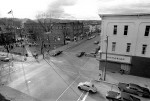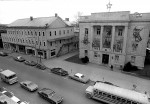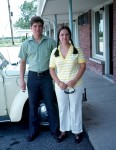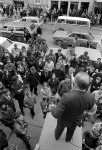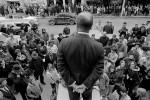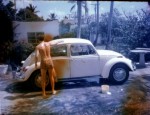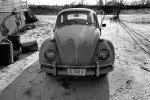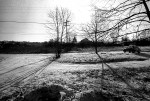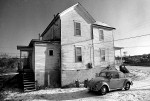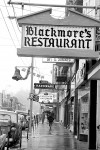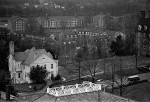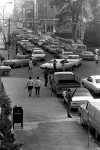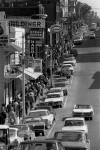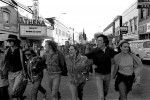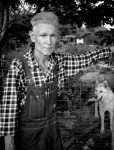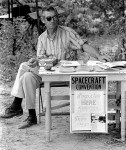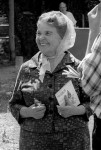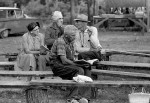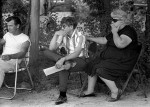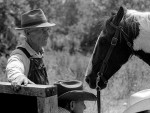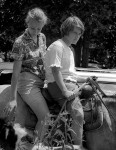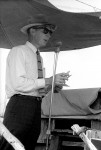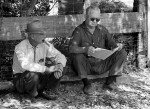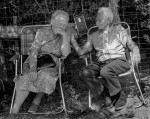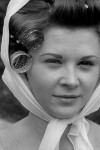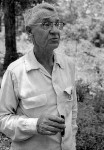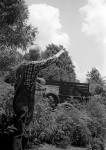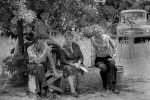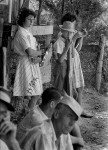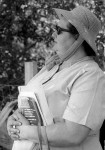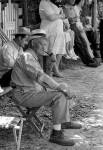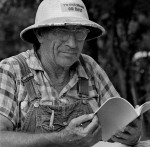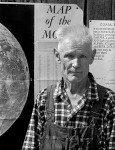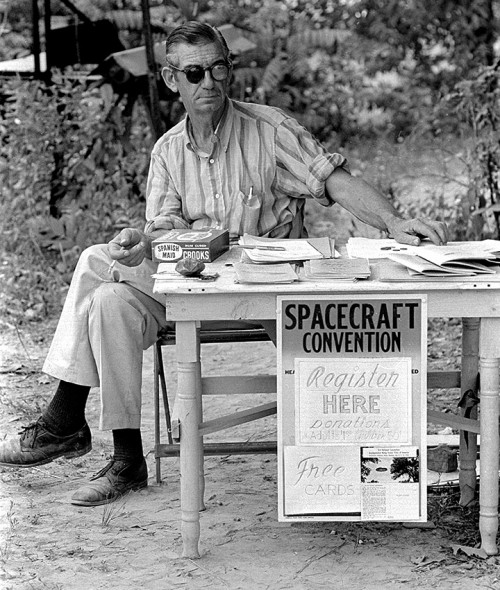 I have to disappoint folks who come looking for photos or stories about UFOs in Cape. On the other hand, I got to spend a whole weekend asking people, “And, what kind of clothes do they wear on Mars and Venus?”
I have to disappoint folks who come looking for photos or stories about UFOs in Cape. On the other hand, I got to spend a whole weekend asking people, “And, what kind of clothes do they wear on Mars and Venus?”
It was the summer of 1966, and I went on my first out-of-town assignment – to the Buck Nelson Flying Saucer Convention in Mountain View, in the Missouri Ozarks. Now that I think of it, I’m not sure it was an actual assignment. I think I just convinced reporters Jerry Obermark and Denny O’Neil that we should jump in my 1959 Buick LaSabre station wagon and light out.
The caption under the photo above read, “Bob Palmer sits at the registration desk at Buck Nelson’s Spacecraft Convention ready to sell visitors copies of My Trip to Mars, the Moon and Venus by Mr. Nelson, More About Flying Saucers, by John Dean, or post cards depicting – in full color – a flying saucer spinning through the air.”
Cult ponders “space brothers”
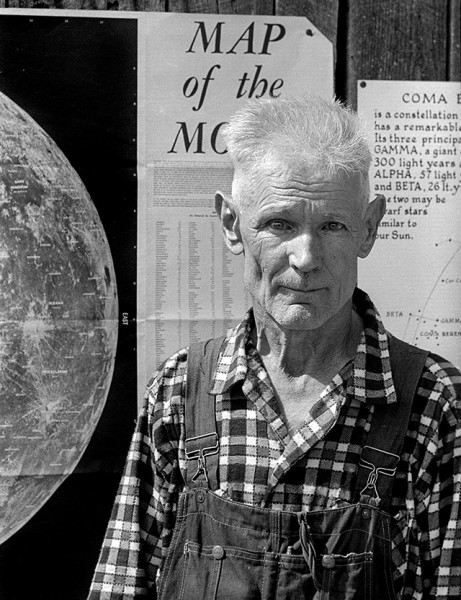 I’m going to let Jerry tell the story the way he wrote in in the June 28, 1966, Missourian. I may toss in a comment or observation from time to time. The gentleman above who has the look of a biblical prophet is Buck, by the way.
I’m going to let Jerry tell the story the way he wrote in in the June 28, 1966, Missourian. I may toss in a comment or observation from time to time. The gentleman above who has the look of a biblical prophet is Buck, by the way.
Buck Nelson of Mountain View, an Ozark community, has more in common with the fabled Buck Rogers than his first name. Mr. Nelson claims to have ridden in space ships to other planets, to have visited and talked with “space brothers” and to be one of their contact men on earth.
Mr. Nelson is nearing 70 and has held a space convention on his 40-acre farm, seven miles northwest of Mountain View, in Howell County, each year since 1954, the first year Mr. Nelson was contacted by spacemen. The crowds for the convention have dwindled in recent years.
This convention was one of the most disappointing.
James L. Hill – space brothers’ contact man
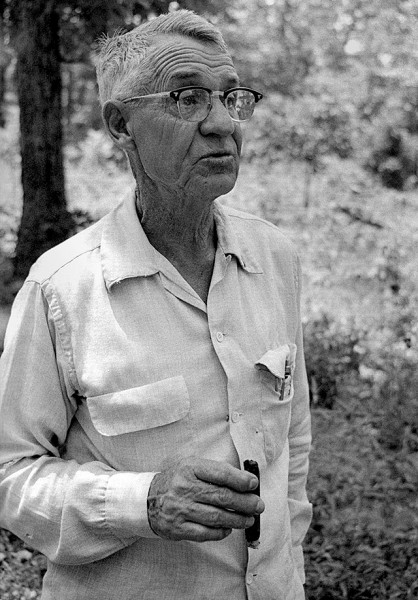 A larger attendance was expected, James L. Hill of Seymour said. Mr. Hill said he is a close friend of Mr. Nelson in addition to being the space brothers’ contact man for southwest Missouri.
A larger attendance was expected, James L. Hill of Seymour said. Mr. Hill said he is a close friend of Mr. Nelson in addition to being the space brothers’ contact man for southwest Missouri.
Mr. Hill explained that he and Mr. Nelson both formerly lived in California. He said Mr. Nelson was once a police detective in the Los Angeles, Calif., Police Department. Mr. Hill said he retired from the U.S. Army with the rank of major in 1920. He worked in different areas since his retirement and has written a few books.
His main interest, however, and the reason for his being at Mr. Nelson’s farm last weekend was to talk about flying saucers and the space brothers. Mr. Nelson, himself, said little. But, Mr. Hill was anything but shy.
Change in appearance
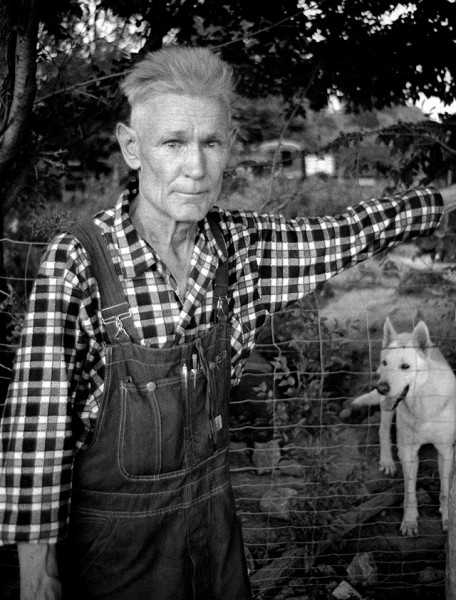 Mr. Hill told how Mr. Nelson looked different in appearance after the space brothers visited him in 1954. His face was white and his eyes looked as if he had seen a vision, Mr. Hill said.
Mr. Hill told how Mr. Nelson looked different in appearance after the space brothers visited him in 1954. His face was white and his eyes looked as if he had seen a vision, Mr. Hill said.
The cult finder’s medical records at the hospital in Texas County show that he formerly had arthritis, Mr. Hill said. After the visit, Mr. Nelson made a marvelous recovery, Mr. Hill said.
Since that first visit, Mr. Nelson has been contacted many times times by the space brothers. He has been taken to other planets and visited several times at his home, Mr. Hill explained. Mr. Hill said he also has been contacted by space brothers. They visited his home, ate meals with him and communicated by telepathy, he said.
Both Mr. Hill and Mr. Nelson were sent to Missouri from California by the space brothers several years ago, Mr. Hill said. He said, for lack of a better word, that a feeling or “hunch” came over them that they should move here. Mr. Nelson also had lived in Denver, Colo., prior to moving here, Mr. Hill said.
Purpose of the visit
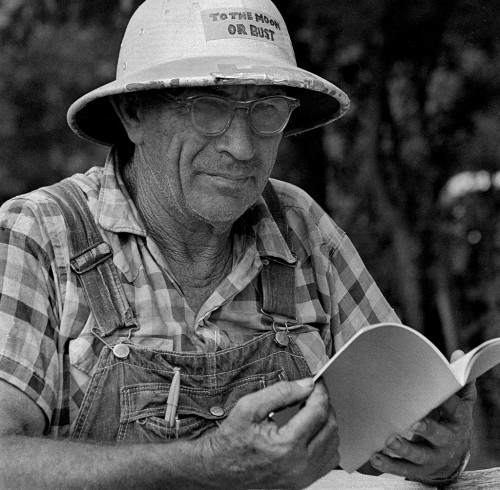 Main purpose of the space brothers visits here, Mr. Hill claimed, is to relay the message that the scientists here should stop experimenting with hydrogen and atomic bombs.
Main purpose of the space brothers visits here, Mr. Hill claimed, is to relay the message that the scientists here should stop experimenting with hydrogen and atomic bombs.
When the spacemen first contacted Mr. Nelson, Mr. Hill noted, they said, “You have a mission and you will be told more as we want you to know.” Since that time, Mr. Hill said he has learned much.
The space visitors that Mr. Hill has seen usually have black beards and are taller than 6 feet. The most recent encounter took place at Mr. Nelson’s house last September, he said.
“Billions of lights” in the sky
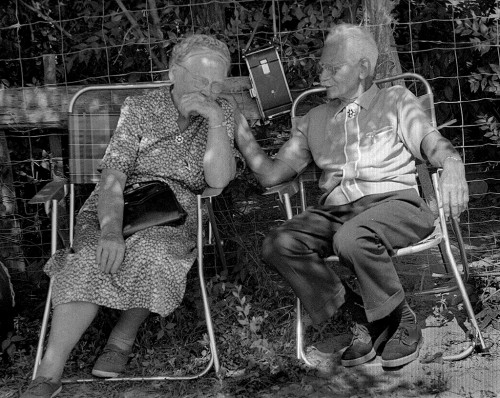 On three consecutive nights, Mr. Nelson said, he saw what he called “billions of lights.” The lights appeared to be 50 to 100 miles north of the farmhouse and were clearly seen from the road near his house. Mr. Hill said he and Mr. Nelson and Mr. and Mrs. Adolph Henn of Willow Springs saw the lights. Mr. and Mrs. Henn told the same story, but they thought it happened in April. The lights were stationary, Mr. Henn said, and they appeared to be about the same size as a fluorescent street light. But there is no highway or town in the area where they appeared, he noted.
On three consecutive nights, Mr. Nelson said, he saw what he called “billions of lights.” The lights appeared to be 50 to 100 miles north of the farmhouse and were clearly seen from the road near his house. Mr. Hill said he and Mr. Nelson and Mr. and Mrs. Adolph Henn of Willow Springs saw the lights. Mr. and Mrs. Henn told the same story, but they thought it happened in April. The lights were stationary, Mr. Henn said, and they appeared to be about the same size as a fluorescent street light. But there is no highway or town in the area where they appeared, he noted.
[Editor’s note: there’s another twist to this story that I’ll save for the end. Hang in there.]
On one of the nights, after Mr. Hill and Mr. Nelson had returned from watching the lights, three “spacemen” walked out of the founder’s yard. One of the men took a gun from his pocket which shot a beam of light “brighter than sunlight.” The ray disintegrated one of Mr. Nelson’s sickly cats, Mr. Hill said.
The visitors from space were all wearing uniforms similar to denim overalls and had black beards. They didn’t say anything when Mr. Nelson spoke to them, first in English, then in Indian sign language. Mr. Hill said he tried to communicate with them by telepathy, but they just walked away.
Space Brothers highly developed
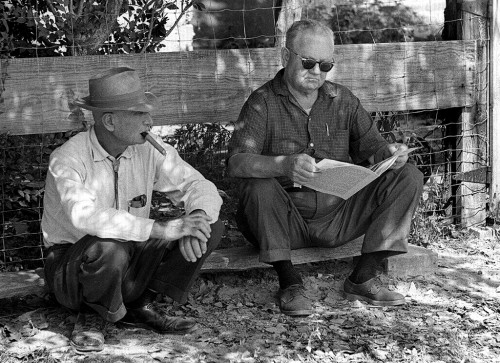 At other times, Mr. Hill said he learned that the space brothers are a much higher developed culture than earthlings. He said they travel at fantastic speeds in any of several types of spaceships. They have no need for anything on earth, he said. The only reason they want to keep scientists from “fooling” with atomic and nuclear power because it could destroy the universe, he said.
At other times, Mr. Hill said he learned that the space brothers are a much higher developed culture than earthlings. He said they travel at fantastic speeds in any of several types of spaceships. They have no need for anything on earth, he said. The only reason they want to keep scientists from “fooling” with atomic and nuclear power because it could destroy the universe, he said.
Several of the spacemen live on earth. Hundreds of thousands of them work as scientists and in Washington, D.C., Mr. Hill said. The United States space program has been infiltrated by them, he added. They normally will not interfere with experiments by the government here, but it things get too dangerous, they will interfere, he said.
Reproduce by thought waves
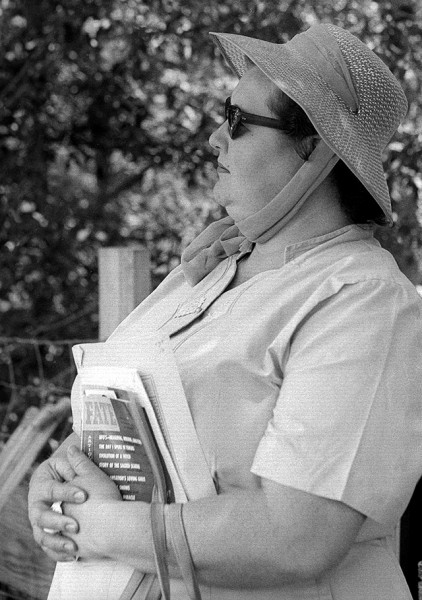 The spacemen live on several of the known and unknown planets, he explained. Many of them live for thousands of years. They can reproduce by thought waves or physically, Mr. Hill said.
The spacemen live on several of the known and unknown planets, he explained. Many of them live for thousands of years. They can reproduce by thought waves or physically, Mr. Hill said.
He said some of their favorite foods when they visited him in California were “peanut butter sandwiches, milk and coffee, but not too much coffee.”
There were religious overtones in most of the speeches and private conversations on spacemen at the convention. Mr. Hill said Jesus Christ was taken up on a spaceship after his death on the Cross. He said that Jesus is the first born son of God and that he now travels on the other planets and talks to the leaders there.
Two Projects
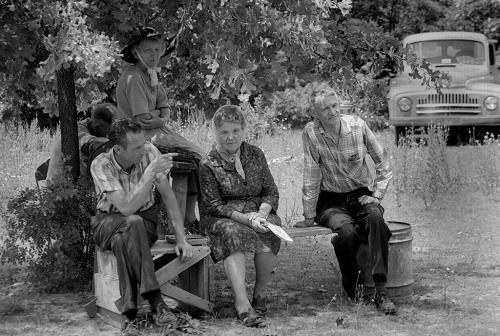 About four years ago, the space brothers told Mr. Hill and Mr. Nelson of two projects for which they were to be the contact men.
About four years ago, the space brothers told Mr. Hill and Mr. Nelson of two projects for which they were to be the contact men.
One of the projects was for the building of a spaceship at the cost of $25 million. The other was a plan to make water available to anyone in the U.S.A free without the use of pipes by simply telephoning Mr. Nelson or Mr. Hill. The water project would cost the government $1.5 billion, Mr. Hill said.
Mr. Hill said he drew up two bills and submitted them to Sen. Edward V. Long of Missouri, but they were not introduced in Congress. Mr. Hill said he could not include any of the secrets as to how the water would be supplied or the spaceship would be built. The bill simply asked for government money to build the center to be headed by Mr. Nelson and Mr. Hill. The space brothers were going to assist the men in both projects. He said he could not give details because he would be breaking a trust with the spacemen.
When Mr. Hill was asked why the projects would cost so much, he said the figures were beyond his understanding, but they had been recommended by the space brothers. He said they would need to build a “nice space center” at Mr. Nelson’s farm. Eventually, the spaceship was to be for the use of everyone in the United States, he said. They would also need to buy some cars and trucks, he added. But the bulk of the expense was unaccounted for. Apparently the space brothers needed exotic metals and expensive equipment for the projects.
Other bizarre tales
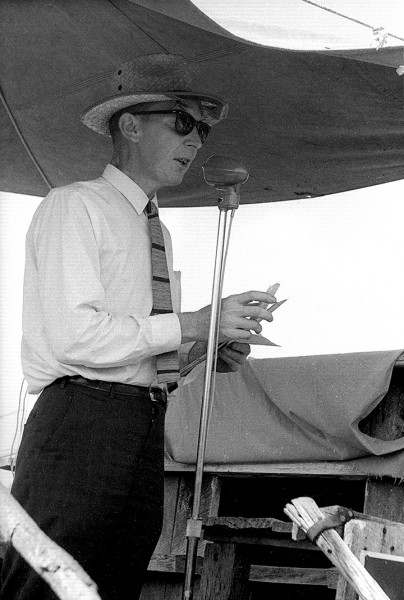 If some of Mr. Hill’s stories seemed strange, it should be added that equally bizarre tales were related by John W. Dean of Hutchinson, Kan.
If some of Mr. Hill’s stories seemed strange, it should be added that equally bizarre tales were related by John W. Dean of Hutchinson, Kan.
Mr. Dean said that the U.S. government has captured a few spacecraft and is keeping the public from knowing about them.
The Kansan explained slide which depict several types of spaceships. He said the ships drew their power from the air by the magnetic pole and they had condensers.
“I guarantee that what I am telling you is as true as we know how to get it. And it’s the thing that will save this country from destruction, if we will adopt what they are offering us. It’s all printed in the UFO magazine,” Mr. Dean said.
Carnival atmosphere
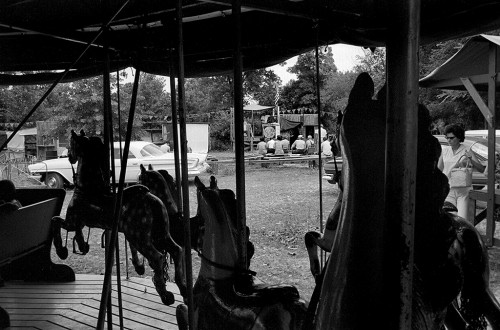 The convention itself was similar to other conventions in only a few respects. There was a carnival atmosphere to some extent. Music from concessions and rides could be heard in the background. Several persons made speeches. Delegates from several states came to the convention to learn about the experiences of others and to relate their own. Persons who had read the advertisement also attended.
The convention itself was similar to other conventions in only a few respects. There was a carnival atmosphere to some extent. Music from concessions and rides could be heard in the background. Several persons made speeches. Delegates from several states came to the convention to learn about the experiences of others and to relate their own. Persons who had read the advertisement also attended.
[Editor’s note: I learned at least two valuable lessons on my first away trip: (1) it’s possible to get a good night’s sleep in a $2-a-night boarding house with the facilities down the hall, and (2) never bet on a sure thing. On the way out of town, I cashed my paycheck, all $50 of it, so I was flush. Looking for a break from conversations about Martians, I wandered over to a carnie joint where I got suckered into a game where you couldn’t lose. The guy with his cigarette pack rolled up in his T-shirt sleeve spotted me an unbelievable number of points toward a goal with a big payoff. Since you accumulated points every round, there was no way to lose (as long as you had an infinite amount of money to keep playing). Just like the train will never get to its destination if it keeps going half-way, it soon became apparent that I was NEVER going to get to the magic number of points. I figured it was the cheapest and most valuable lesson I ever got for $20. Years later, I would find a book, Eying the Flash – The Education of a Carnival Con Artist – that explained how the scam worked.]
Benches for audience
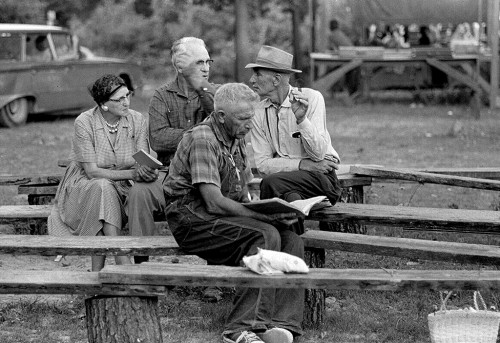 A weather-worn building on Mr. Nelson’s farm served as headquarters for some visitors. Six rows of benches accommodated listeners. Microphones were set up on the platform and sandwiches and refreshments were available.
A weather-worn building on Mr. Nelson’s farm served as headquarters for some visitors. Six rows of benches accommodated listeners. Microphones were set up on the platform and sandwiches and refreshments were available.
The rides and concessions were an added attraction this year, but were not to distract from the business of the convention – to educate the people about the spacemen, Mr. Hill said. Other conventions are held annually at several locations, Mr. Hill added. One is scheduled for Giant Rock, Calif. About 10,000 persons are expected to attend, he said.
“Spaceships Welcome”
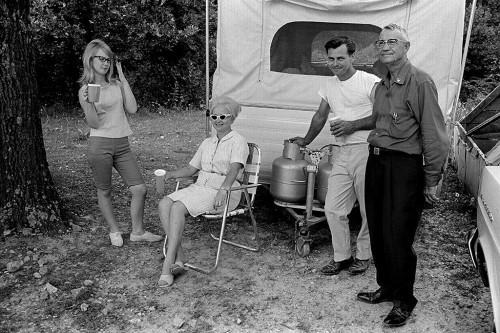 Signs reading, “Spaceships Welcome” were posted around the convention area and were available to anyone who wanted one for his car.
Signs reading, “Spaceships Welcome” were posted around the convention area and were available to anyone who wanted one for his car.
The convention closed Monday. The people of Mountain View will talk about the event for only a short time. Few townspeople were curious enough to attend.
Nevertheless, most of those who commented on Buck Nelson’s space convention did not indicate skepticism in Mr. Nelson or even disbelief in this stories.
One woman said she couldn’t see why the government was spending so much money to go to the moon when they could “just come out and ask Buck.”
Here’s Jerry at work
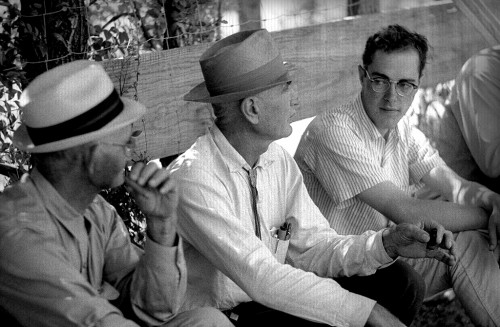 I’m not sure how Denny and Jerry figured out who was going to write the story. I give Jerry credit for writing it right down the middle. He reported it straight without poking fun at anyone, although I’m not sure I’ve ever seen a story with so many attributions and “he saids.” We could only stand about two hours at a stretch before we’d pile in the car to drive away to decompress. Jerry is the guy on the right trying to keep a straight face.
I’m not sure how Denny and Jerry figured out who was going to write the story. I give Jerry credit for writing it right down the middle. He reported it straight without poking fun at anyone, although I’m not sure I’ve ever seen a story with so many attributions and “he saids.” We could only stand about two hours at a stretch before we’d pile in the car to drive away to decompress. Jerry is the guy on the right trying to keep a straight face.
The crazy kicker
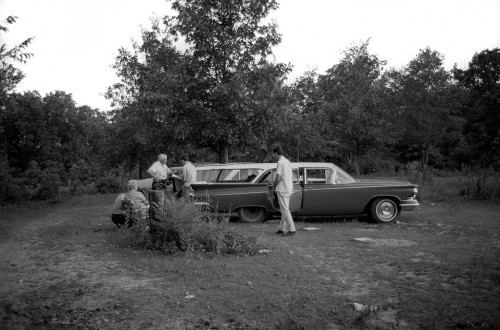 I promised you a twist to the “billions lights” story. Well, in addition to the lights, Buck told the tale about going out of town one weekend and coming back to find a tree that had been in his yard gone without a trace. “The space brothers must have wanted to take that tree to study. They probably levitated it right away without leaving so much as a leaf or piece of bark behind.”
I promised you a twist to the “billions lights” story. Well, in addition to the lights, Buck told the tale about going out of town one weekend and coming back to find a tree that had been in his yard gone without a trace. “The space brothers must have wanted to take that tree to study. They probably levitated it right away without leaving so much as a leaf or piece of bark behind.”
When we started to head back to Cape, I noticed that I had picked up a nail in a tire, resulting in a slow leak. We stopped at the first service station in Mountain View where the kid who fixed my flat was curious about what we strangers were doing in town.
“We’re covering Buck Nelson’s Flying Saucer Convention,” I explained.
“That old Buck,” the kid said, “We have a bundle of fun with him. Every once in awhile we’ll go out there with a bunch of rockets and shoot them off over this house. The best prank we played was one weekend when he was out of town. Me and a bunch of my buddies cut down this tree in his front yard and made off with every speck of it. We didn’t leave a single scrap of sawdust behind…..”
The Sorry-There-Aren’t-Any-UFOs Photo Gallery
Here are a batch of photos from the weekend. I have a pdf copy of Buck’s book, My Trip to Mars, the Moon and Venus, but it’s about 10 megs, bigger than the blog software will allow me to upload. If anyone wants to read it, drop me an email and we’ll work out something. I don’t see any copyright notes on it and Buck, I’m sure, has gone wherever the space brothers wanted to take him by now. Click on any photo to make it larger, then use your arrow keys to step through the gallery.
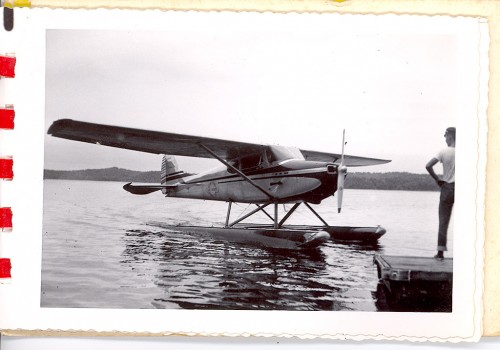 This tiny scrapbook looks like it captured my first plane ride when I was about four years old. Lake of the Ozarks kept twitching in the back of my mind. Then, I thought “Bagnell Dam,” not knowing for sure if the two phrases were connected.
This tiny scrapbook looks like it captured my first plane ride when I was about four years old. Lake of the Ozarks kept twitching in the back of my mind. Then, I thought “Bagnell Dam,” not knowing for sure if the two phrases were connected.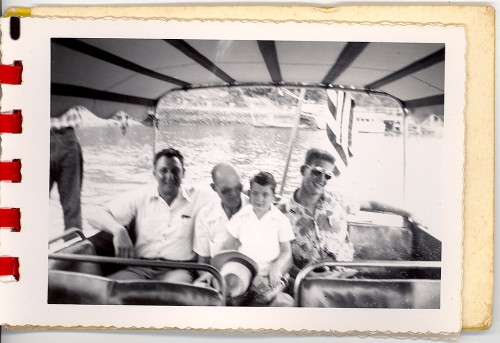 Troas “Bones” Joiner is on the left. He was the Joiner part of Steinhoff, Kirkwood and Joiner Construction. Bones was a ruddy-faced, good-hearted man who knew his way around a wrench and was artist with a bulldozer. He was a Cat skinner of the first order. His son, Bill, is on the right. I’m sitting on Dad’s lap.
Troas “Bones” Joiner is on the left. He was the Joiner part of Steinhoff, Kirkwood and Joiner Construction. Bones was a ruddy-faced, good-hearted man who knew his way around a wrench and was artist with a bulldozer. He was a Cat skinner of the first order. His son, Bill, is on the right. I’m sitting on Dad’s lap.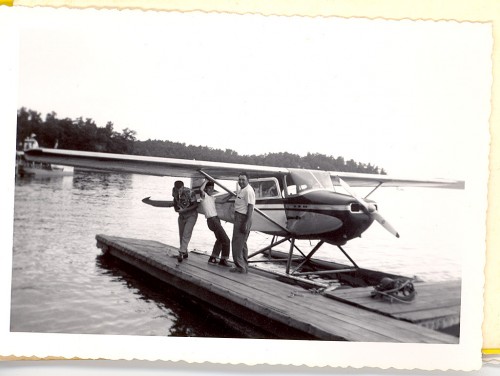 I don’t have any recollection of my first plane ride. Not only was it a small plane, it was a seaplane on top of that. I think I’ve only flown in a pontoon plane two or three times, once to the Dry Torguas and back (obviously).
I don’t have any recollection of my first plane ride. Not only was it a small plane, it was a seaplane on top of that. I think I’ve only flown in a pontoon plane two or three times, once to the Dry Torguas and back (obviously).
